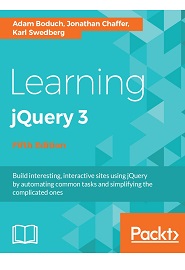
English | 2017 | ISBN: 978-1785882982 | 448 Pages | PDF, EPUB, AZW3 | 19 MB
Create efficient and smart web applications with jQuery 3.0 using this step-by-step practical tutorial
If you are a web developer and want to create web applications that look good, are efficient, have rich user interfaces, and integrate seamlessly with any backend using AJAX, then this book is the ideal match for you. We’ll show you how you can integrate jQuery 3.0 into your web pages, avoid complex JavaScript code, create brilliant animation effects for your web applications, and create a flawless app.
We start by configuring and customising the jQuery environment, and getting hands-on with DOM manipulation. Next, we’ll explore event handling advanced animations, creating optimised user interfaces, and building useful third-party plugins. Also, we’ll learn how to integrate jQuery with your favourite back-end framework.
Moving on, we’ll learn how the ECMAScript 6 features affect your web development process with jQuery. we’ll discover how to use the newly introduced JavaScript promises and the new animation API in jQuery 3.0 in great detail, along with sample code and examples.
By the end of the book, you will be able to successfully create a fully featured and efficient single page web application and leverage all the new features of jQuery 3.0 effectively.
What You Will Learn
- Create custom interactive elements for your web designs
- Find out how to create the best user interface for your web applications
- Use selectors in a variety of ways to get anything you want from a page when you need it
- Master events to bring your web pages to life
- Add flair to your actions with a variety of different animation effects
- Discover the latest features available in jQuery with the latest update of this incredibly popular title
- Using jQuery npm Packages
- Build a modern single-page web application
- Understand the workflow of an Aurelia application
- Design reusable web components, which can be shared and integrated into various frameworks and libraries
- Write clean, modular, and testable code that will be easy to maintain and evolve
- Use all the latest–and even future–web standards, so the application gathers minimal technical debt
Resolve the captcha to access the links!